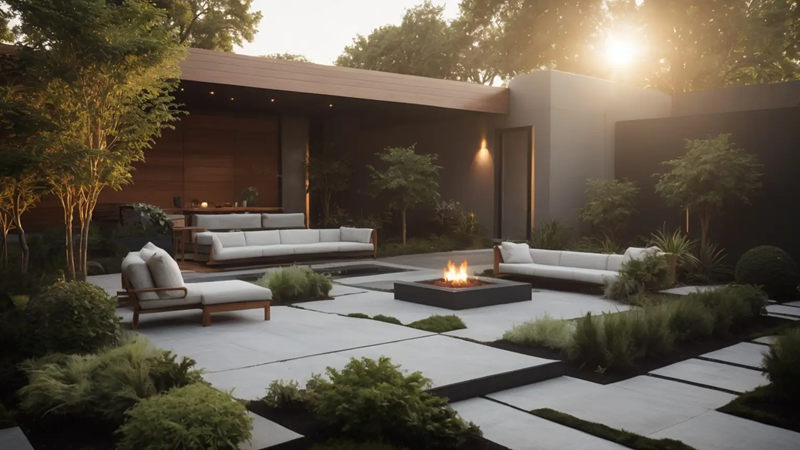A well-designed landscape does more than beautify your property—it creates an inviting atmosphere, enhances functionality, and increases property value. Whether you’re a homeowner aiming to craft an outdoor retreat or a professional seeking innovative ideas, understanding the principles of landscape design is essential.
This guide explores how to create a stunning and practical landscape design, blending aesthetics with usability. By following proven strategies and design principles, you can transform any outdoor space into a place of beauty, comfort, and functionality.
Why Landscape Design Matters
Landscape design is not just about planting trees and flowers. It’s about harmonizing nature with architecture, creating spaces that complement daily life while being sustainable.
Benefits of a Functional and Beautiful Landscape Design
-
Curb Appeal – A well-planned landscape immediately boosts the visual appeal of your property.
-
Property Value – Real estate studies show that good landscaping can increase property value by up to 20%.
-
Lifestyle Enhancement – Outdoor spaces provide relaxation, entertainment, and recreational opportunities.
-
Environmental Benefits – Smart landscaping improves air quality, conserves water, and provides shade that reduces energy costs.
-
Personal Satisfaction – A thoughtfully designed landscape creates a personal sanctuary tailored to your lifestyle.
When you create a stunning and practical landscape design, you invest not only in your property but also in your well-being.
Assess Your Space
Before diving into planting and construction, assess the space you’re working with.
Key Considerations:
-
Size and Shape – The dimensions of your yard will determine the scope of your design.
-
Sunlight and Shade – Observe how sunlight moves across your property throughout the day.
-
Soil Quality – Test soil pH and drainage capacity for better plant selection.
-
Climate and Weather – Consider seasonal changes and weather conditions in your region.
-
Existing Structures – Take into account fences, patios, pools, or driveways.
Understanding these elements ensures your design is realistic, functional, and long-lasting.
Define Your Purpose
Every outdoor space should serve a purpose. Ask yourself:
-
Do you want a space for entertaining guests?
-
Are you creating a child- or pet-friendly environment?
-
Do you need a peaceful retreat for relaxation?
-
Is gardening or sustainable food production part of your plan?
Clearly identifying your goals makes it easier to create a stunning and practical landscape design tailored to your lifestyle.
Develop a Design Plan
A design plan brings clarity and direction to your landscaping project.
Essential Components of a Plan:
-
Zones – Divide your yard into functional zones such as dining, relaxation, and play areas.
-
Traffic Flow – Incorporate pathways for smooth movement between zones.
-
Focal Points – Add elements such as fountains, sculptures, or fire pits as visual anchors.
-
Balance and Symmetry – Create harmony by balancing plants, shapes, and structures.
-
Color Palette – Use colors to set moods; cool tones for calm, warm tones for vibrancy.
Many homeowners consult professionals, but even DIY enthusiasts can sketch basic plans to visualize their ideas.
Choose the Right Plants
Plants are the backbone of any landscape. Selecting the right ones ensures your garden remains low-maintenance, beautiful, and practical.
Plant Selection Tips:
-
Native Plants – Adapted to local conditions, requiring less water and maintenance.
-
Evergreens – Provide year-round greenery and structure.
-
Perennials vs. Annuals – Perennials return yearly; annuals add seasonal color.
-
Layering – Combine tall trees, medium shrubs, and ground cover for depth.
-
Seasonal Interest – Ensure blooms, foliage, or textures enhance your space in every season.
By carefully choosing plants, you balance function and beauty in your outdoor design.
Hardscape Elements
Hardscape refers to the non-living elements of landscaping—structures that provide functionality and durability.
Popular Hardscape Features:
-
Patios and Decks – Perfect for entertaining and outdoor dining.
-
Walkways – Guide visitors through your garden while adding charm.
-
Retaining Walls – Provide structure, prevent erosion, and add visual depth.
-
Pergolas and Gazebos – Create shaded retreats.
-
Outdoor Kitchens – Extend your living space outdoors.
When balanced with greenery, hardscapes help you create a stunning and practical landscape design that’s functional for everyday use.
Incorporate Water Features
Water elements introduce tranquility and elegance.
-
Fountains – Compact and ideal for small gardens.
-
Ponds – Encourage biodiversity while adding visual charm.
-
Waterfalls – Create soothing sounds and dynamic visuals.
-
Streams – Add natural flow to your garden.
These features not only enhance beauty but also promote relaxation and mindfulness.
Lighting Your Landscape
Outdoor lighting ensures your design shines even after sunset.
Types of Outdoor Lighting:
-
Pathway Lights – Improve safety while guiding visitors.
-
Spotlights – Highlight trees, sculptures, or architectural features.
-
Ambient Lighting – Set a relaxing mood with warm lights.
-
Solar Lights – Eco-friendly and cost-effective.
Strategic lighting adds drama and functionality, extending the usability of outdoor spaces into the night.
Sustainability in Landscape Design
Modern landscaping emphasizes sustainability. Eco-friendly design not only reduces environmental impact but also saves resources.
Sustainable Practices:
-
Xeriscaping – Use drought-resistant plants to minimize water use.
-
Rainwater Harvesting – Collect rainwater for irrigation.
-
Composting – Reduce waste and enrich soil naturally.
-
Native Landscaping – Encourage local wildlife and reduce maintenance.
Integrating sustainability ensures your design remains practical for years while supporting the environment.
Personalize with Unique Touches
The best landscapes reflect personal style. Consider adding:
-
Outdoor Art – Sculptures, murals, or handcrafted décor.
-
Furniture – Comfortable, weather-resistant seating for relaxation.
-
Themed Gardens – Japanese Zen gardens, Mediterranean courtyards, or wildflower meadows.
-
Edible Gardens – Blend beauty and function by planting herbs, vegetables, or fruit trees.
Customization ensures your outdoor space feels truly yours.
Maintenance and Longevity
Designing is just the beginning—maintenance ensures long-term success.
Maintenance Tips:
-
Regular Pruning – Keep plants healthy and well-shaped.
-
Seasonal Clean-Up – Remove debris, weeds, and dead plants.
-
Lawn Care – Mow, fertilize, and aerate for lush greenery.
-
Pest Management – Use natural or integrated pest control methods.
-
Irrigation Systems – Automated systems save time and conserve water.
By incorporating easy maintenance practices, you ensure that your landscape remains stunning and practical year after year.
Common Mistakes to Avoid
Even the most enthusiastic homeowners can make errors. Avoid these pitfalls:
-
Overcrowding Plants – Leads to competition for nutrients and unhealthy growth.
-
Ignoring Climate – Choosing plants not suited to your region.
-
Poor Drainage – Causes flooding and root rot.
-
Lack of Planning – Jumping into planting without a solid design plan.
-
Neglecting Maintenance – Allowing weeds, pests, or overgrowth to ruin your design.
Conclusion
Creating a landscape is more than a weekend project—it’s an investment in beauty, function, and sustainability. When you create a stunning and practical landscape design, you bring together elements of nature, architecture, and lifestyle to form a harmonious outdoor space.
By following the steps outlined—assessing your space, defining goals, planning layouts, selecting plants, incorporating hardscapes, adding water and lighting features, and committing to sustainability—you’ll craft an environment that not only looks incredible but also serves your daily needs.
Your outdoor space should reflect who you are, offering comfort, joy, and long-term value. With thoughtful planning and consistent care, any homeowner can achieve a truly stunning and practical landscape design.

